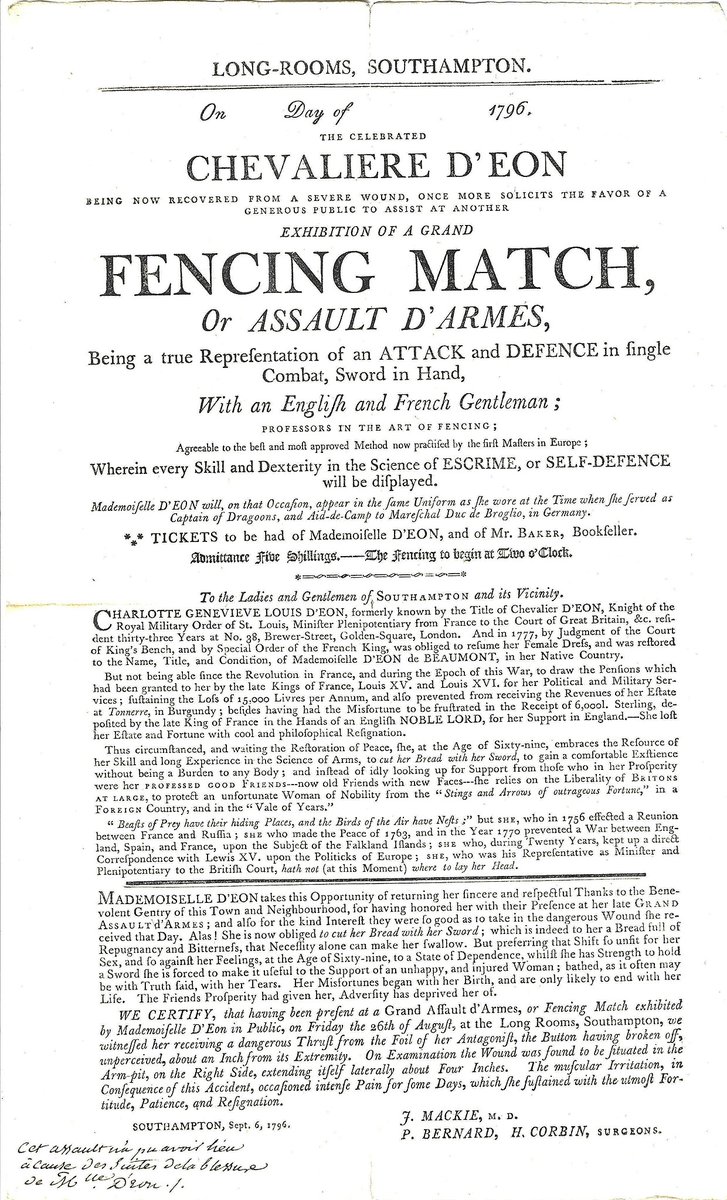The final #ArchiveZ of the week is F for fencing, and we want to use it to tell something of the remarkable tale of Chevalier D’Eon, mentioned here in this advertisement for a fencing match in 1796.
If you don’t know about Chevalier D’Eon read on…
#ExploreYourArchive
 https://abs.twimg.com/emoji/v2/... draggable="false" alt="⬇️" title="Pfeil nach unten" aria-label="Emoji: Pfeil nach unten">
https://abs.twimg.com/emoji/v2/... draggable="false" alt="⬇️" title="Pfeil nach unten" aria-label="Emoji: Pfeil nach unten">
If you don’t know about Chevalier D’Eon read on…
#ExploreYourArchive
Chevalier D’Eon was born in Burgundy in 1728, and became, amongst other things, a diplomat, soldier and a spy during their life.
And yes, we do mean ‘their’ life.
Chevalier D’Eon died at the age of 81. For the first 49 years of their life, D’Eon lived as a man. For the rest of their life, they lived as a woman.
Remember, this is during the late 18th Century!
During their life, D’Eon fought in the Seven Years War, and helped to draft the treaty to end this conflict; became a French spy in British government, and ostracised by the French leaders…
Caught between the two camps of the comte de Guerchy and comte de Broglie, D’Eon was demoted from their diplomatic role, before being the subject of an extradition order from France. An order that the British refused to enforce.
After much wrangling, D’Eon remained in London as a spy in political exile from France.
At this point questions about D& #39;Eon& #39;s gender began. As something of a celebrity in 1771, bookmakers were taking bets on D’Eon’s gender, and it was a question of ‘national interest’!
Eventually D’Eon claimed that they had been born a female, but society had dictated they be raised as a male for reasons of inheritance.
After 14 months of arguments about their gender, D’Eon was permitted to return to France, but had to dress as a woman, and was banished to Tonerre in France in 1777. D’Eon could continue to wear the Order of St. Louis gained during the Seven Years War however.
By 1785, D’Eon was allowed to return to England again.
By 1796, our advertisement has D’Eon scheduled to participate in a fencing match in Southampton. D’Eon had run out of money, and needed to raise funds, hence their planned participation in this fight.
We say & #39;planned& #39;...
D’Eon was seriously injured before the fight occurred, and it never took place.
D’Eon was seriously injured before the fight occurred, and it never took place.
In 1806, having spent time in a debtors prison, D’Eon suffered paralysis after a fall. They remained bedridden for four years before their death in 1810.
D’Eon’s story is remarkable in all sorts of ways, and the @BritishMuseum have a insight into it online which we encourage you to read: https://www.britishmuseum.org/collection/desire-love-and-identity/chevalier-deon">https://www.britishmuseum.org/collectio...
Records about D’Eon can be found today @UoLLibrary, whilst @BritishMuseum holds pictures and other works relating to Chevalier D’Eon.
Go check them both out!
Go check them both out!
And finally from us, isn’t it wonderful where one small prompt can lead? From a single poster we hold in our collections, we can find out so much about a remarkable person from history!
#ExploreYourArchive
#InspiredbyArchives
#ArchiveZ
#ExploreYourArchive
#InspiredbyArchives
#ArchiveZ
We should add one more thing to this thread!
The Beaumont Society was named after Chevalier D& #39;Eau, and continues to this day to do important work supporting the transgender community.
You can find out more here: https://www.beaumontsociety.org.uk/ ">https://www.beaumontsociety.org.uk/">...
The Beaumont Society was named after Chevalier D& #39;Eau, and continues to this day to do important work supporting the transgender community.
You can find out more here: https://www.beaumontsociety.org.uk/ ">https://www.beaumontsociety.org.uk/">...

 Read on Twitter
Read on Twitter " title="The final #ArchiveZ of the week is F for fencing, and we want to use it to tell something of the remarkable tale of Chevalier D’Eon, mentioned here in this advertisement for a fencing match in 1796. If you don’t know about Chevalier D’Eon read on… #ExploreYourArchivehttps://abs.twimg.com/emoji/v2/... draggable="false" alt="⬇️" title="Pfeil nach unten" aria-label="Emoji: Pfeil nach unten">" class="img-responsive" style="max-width:100%;"/>
" title="The final #ArchiveZ of the week is F for fencing, and we want to use it to tell something of the remarkable tale of Chevalier D’Eon, mentioned here in this advertisement for a fencing match in 1796. If you don’t know about Chevalier D’Eon read on… #ExploreYourArchivehttps://abs.twimg.com/emoji/v2/... draggable="false" alt="⬇️" title="Pfeil nach unten" aria-label="Emoji: Pfeil nach unten">" class="img-responsive" style="max-width:100%;"/>


